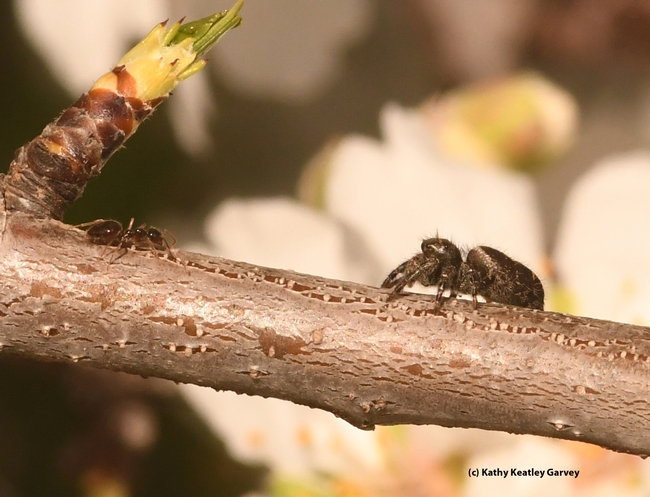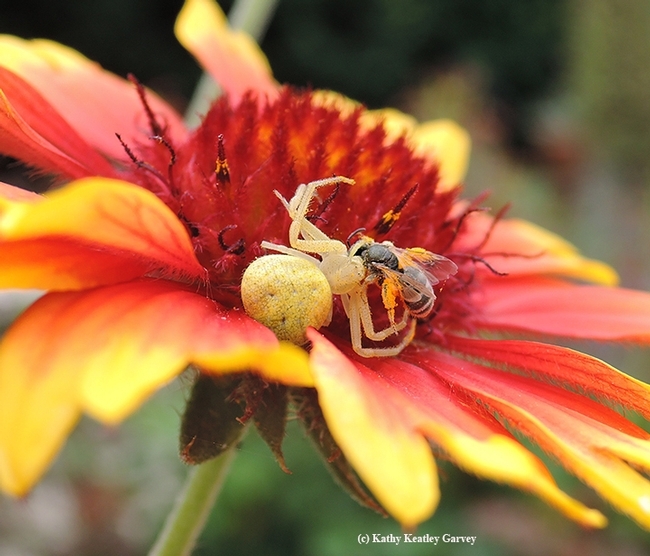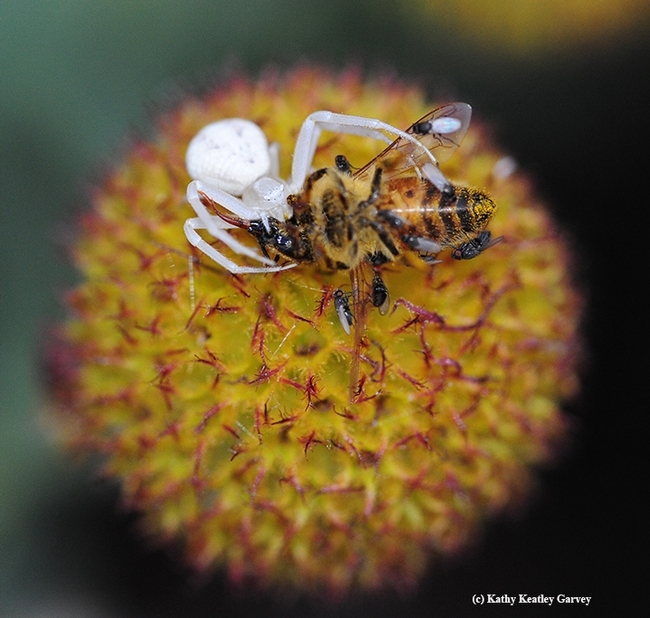- Author: Kathy Keatley Garvey
To be a fly on Friday, what a day!
Entomologists who came up with "Friday Fly Day" are having a lot of fun posting images on social media of flies on Friday.
If you access WikiHow, "What to Do on a Friday Night," you'll find all kinds of suggestions. For instance:
- Watch a movie (that's do-able)
- Challenge friends to a game night (does anybody play games any more?)
- Treat yourself to a spa at home (a spa?)
- Give yourself a makeover (a what?)
- Cook a nice meal (how nice is nice?)
- Treat yourself to cocktail (some of us prefer coffee or water)
- Read a book or a magazine (did that, already)
- Start a new hobby (who has the time? Other hobbies are failing)
- Pamper your pet (he's already pampered; he has his own Facebook page, Vito and His Friends)
- Throw a karaoke or dance party (the neighbors would not like that)
- Work on an artistic or crafty project (some of us are crafty but not artistic)
- Start a bonfire (not in California!)
- Do something physically active (stationary bikes are good)
- and on and on and on....
Nowhere, but nowhere, does it say to take an image of a fly on Friday.
It doesn't have to be a fly on a wall. It can be a fly on a flower. But it has to be a fly on a Friday.
This one is a syrphid fly, aka flower fly or hover fly (and often mistaken for a honey bee) foraging on a blanket flower, or Gaillardia.
Gaillardia, a genus in the sunflower family, Asteraceae, is named for an 18th century French magistrate/botanist, Maître Gaillard de Charentonneau.
Maître Gaillard de Charentonneau, no doubt, never observed Friday Fly Day but being a botanist, he probably loved pollinators.
Cheers to a syrphid fly on "his" flower. (Well, it is a pollinator)
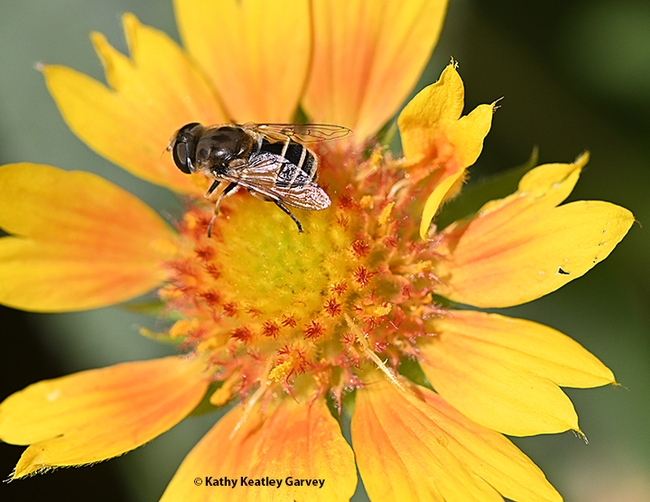
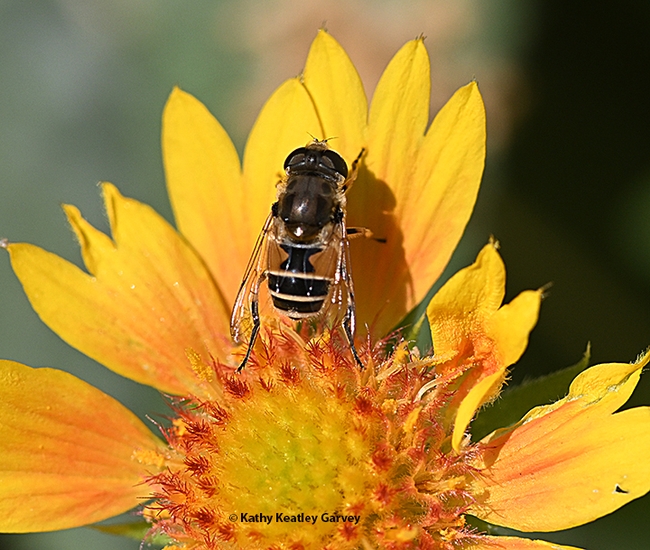
- Author: Kathy Keatley Garvey
Nothing says National Pollinator Week more than a honey bee coated in pollen.
Make mine yellow. Yellow pollen.
There's plenty of time to prepare. National Pollinator Week is June 21-27.
You can register your activities--make that "socially distant activities" to the official Pollinator Week events map.
You can request local buildings to light up yellow and orange in support of pollinators.
You can sign and mail proclamations to your governor in support of Pollination Week.
And, you can celebrate the week by taking an image of a pollinator.
We ventured over to the UC Davis Ecological Garden, Student Farm, Agricultural Sustainability Institute, to capture these two images of a honey bee blanketed with pollen as she foraged--appropriately--on a blanket flower, Gaillardia. The plant is a member of the sunflower family, Asteraeae, and native to North and South America.
The Pollinator Partnership, which sponsors National Pollinator Week, points out that about 75 percent of all flowering plant species "need the help of animals to move their heavy pollen grains from plant to plant for fertilization."
PP also relates that:
- About 1000 of all pollinators are vertebrates such as birds, bats and small animals.
- Most pollinators (abut 200,000 species) are beneficial insects such as flies, beetles, wasps, ants, butterflies, moths and bees.
- Pollinators are often keystone species, meaning that they are critical to an ecosystem.
Are you ready for National Pollinator Week?
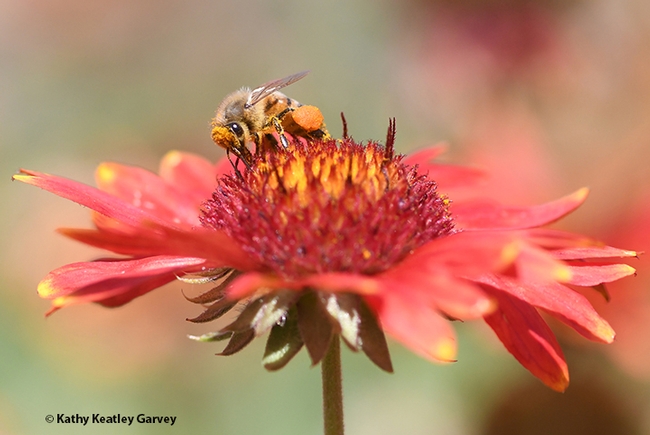
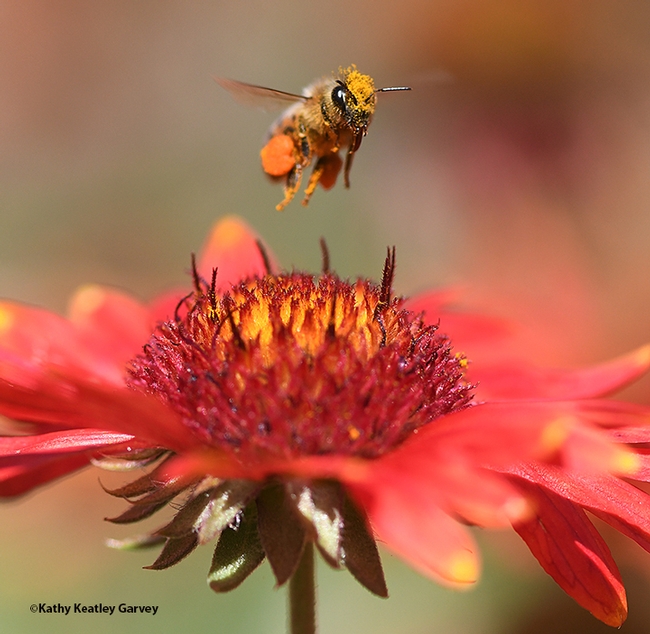
- Author: Kathy Keatley Garvey
You may have lost track of the hours, days, weeks and months due to the coronavirus pandemic, but how can you forget National Pollinator Week?
Especially if you've ventured out in your yard, garden or park and witnessed the pollinators doing what they do best.
National Pollinator Week, set June 22-28, is a "time to celebrate pollinators and spread the word about what you can do to protect them," according to the sponsor, Pollinator Partnership.
As they write on their website: "Thirteen years ago the U.S. Senate's unanimous approval and designation of a week in June as 'National Pollinator Week' marked a necessary step toward addressing the urgent issue of declining pollinator populations. Pollinator Week has now grown into an international celebration of the valuable ecosystem services provided by bees, birds, butterflies, bats and beetles."
So, what can you do to observe Pollinator Week? The Pollinator Partnership says this year won't be a "typical Pollinator Week."
"We urge everyone to hold a socially distant, appropriate event. In an effort to lighten the load on state governments during this time, we are not pursuing formal state proclamations this year, but will continue to post proclamations that we do receive. Moreover, we encourage everyone to go outside and spend some time with the bees and butterflies that inspire hope in many."
Great idea.
And, when we think of Pollinator Week, we think of the honey bee totally dusted with pollen on a blanket flower, Gaillardia, in our pollinator garden in Vacaville, Calif.
The bee just couldn't get enough of the pollen.
We just couldn't get enough photos. Bravo, Ms. Honey Bee!
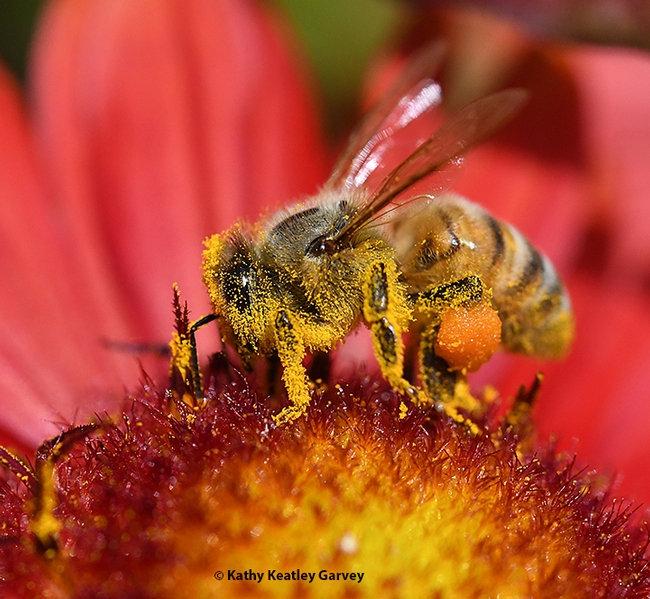
- Author: Kathy Keatley Garvey
Did you observe World Bee Day today?
Every year on May 20, the United Nations asks us to think about this day, "to raise awareness of the importance of pollinators" and "the threats they face and their contribution to sustainable development."
Some 20,000 species of bees inhabit our world, but the "poster child" is the honey bee, Apis mellifera.
"The recent COVID-19 pandemic has had an undeniable impact on the beekeeping sector affecting the production, the market and as a consequence, the livelihoods of beekeepers," the World Bee Day website tells us.
"To mark the Day, a virtual event--under the theme "Bee Engaged"--highlighted the importance of traditional knowledge related to beekeeping, the use of bee-derived products and services, and their importance in achieving the SDGs. If you missed it, you can watch it here!"
"To celebrate #WorldBeeDay, renowned actors, singers, chefs and media professionals also recorded poems related to bees and beekeeping, some recalling how the behavior of bees so often mirrors that of human beings across our planet. Listen to the poems now and bee inspired."
Meanwhile, a pollen-dusted honey bee in our pollinator garden in Vacaville, Calif., totally engaged us as she foraged on Gaillardia, aka "blanket flower." Gaillardia, a member of the sunflower family Asteracae, resembles the colorful maroon and gold Native American blankets. It's named for 18th century French magistrate and botanist Maître Gaillard de Charentonneau.
This honey bee went about her bee-sy-ness and then, weighted with pollen, took flight. It's a wonder she could see to return home to her colony.
Happy World Bee Day!
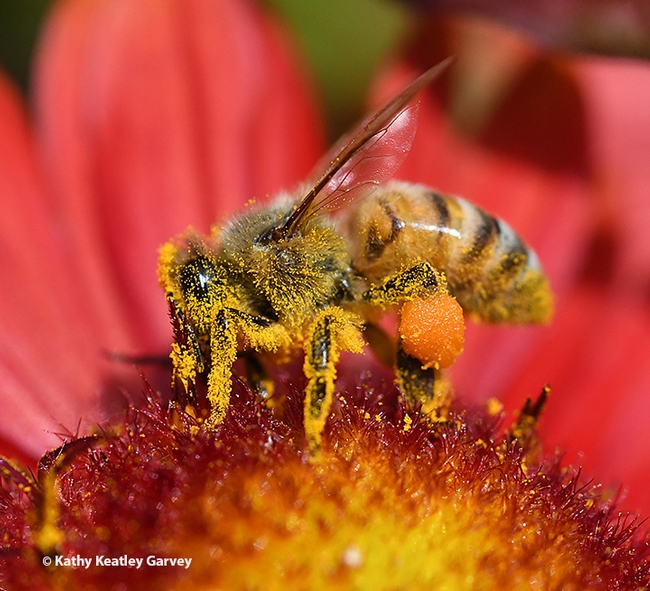
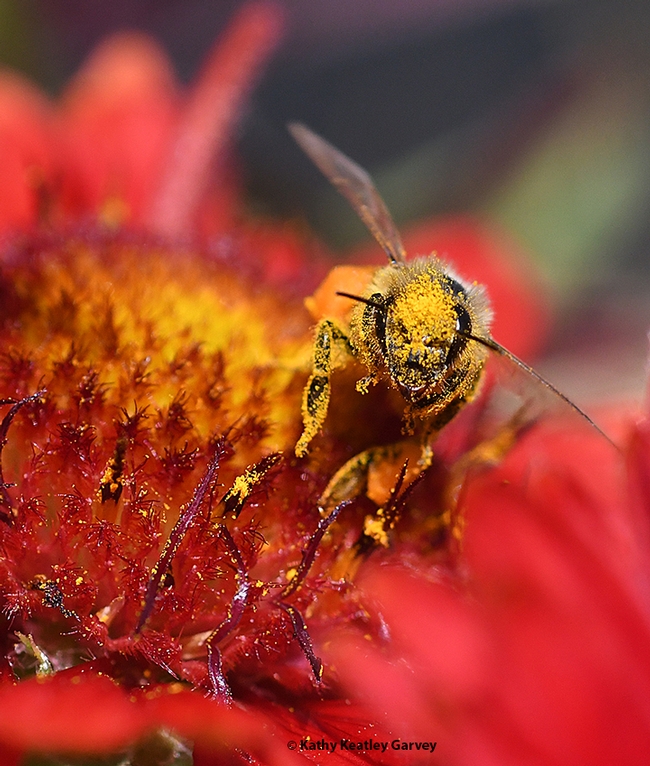
- Author: Kathy Keatley Garvey
I did not save a spider yesterday.
Did not save one today, either.
Well, if I had seen one....
Wednesday, March 14 was "Save a Spider Day" in the United States, according to a post by the Entomological Society of America (ESA). Darn, I missed it!
ESA usually focuses on insects (spiders are not insects) but ESA is all inclusive in this welcoming world of arthropod diversity.
Their online text is worth repeating:
"March 14 is Save A Spider Day in the U.S. and while Charlotte and Peter Parker have been fighting the good fight to redeem the spider's reputation, arachnophobia is still running rampant, especially in the United States. One study conducted during a freshman entomology class at Colorado State University found that "the most commonly mentioned specific factor in spider fear was bites and the perceived danger of spiders with figures indicat[ing] that spider fear levels of college students in Colorado are substantially higher than those reported from European general populations."But are spiders the nightmare they've always been portrayed to be? Do they bite? Do they carry diseases? Are brown recluse spiders everywhere just waiting to strike?
"First of all, a lot of those spider bites you've heard about weren't actually spider bites. A study in the Journal of Medical Entomology has shown that there are several medical conditions that can be commonly misdiagnosed as spider bites including "bacterial, viral, and fungal infections; vasculitis; dermatological conditions; bites and stings from other arthropods; and miscellaneous causes such as allergies or drug reactions, chemical burns, reactions to poisonous plants, or diabetic ulcers." The study also expanded on the idea that Hobo Spiders are disease-transferring which it turns out, they are not. Other common house spiders have also had their name cleared when it comes to spreading MRSA."
The ESA then turned to the brown recluse spiders, pointing out the misidentification and the false information about bites: "Take this study where an infestation of 2,055 brown recluse spiders was collected in a Kansas home that a family had been living in for many years, all without ever receiving a spider bite."
"So that spider in your cupboard?" ESA asks. "Probably not a brown recluse. It's probably not carrying a disease. And it may have just killed a tick for you. So try saving a spider today, it's worth it."
The last time I saw a spider was on Valentine's Day, Feb. 14. It was a jumping spider perched on an almond tree on Bee Biology Road, University of California, Davis. It had crossed paths with a winter ant (Prenolepis imparis). Neither wanted to be anyone's Valentine. Neither needed saving.
But I distinctly remember the other spiders I have seen and photographed in our pollinator garden. They didn't need saving, either.
Well, perhaps the prey needed saving...but everybody has to eat!
